Epson PowerLite Pro Cinema 9500 UB LCD Projector HT Labs Measures
Black: 0.0014
White: 19
Full-On/Full-Off Contrast Ratio: 13,367:1
All the measurements here, unless noted otherwise, were taken with the projector in its THX Color mode, calibrated and adjusted for the most accurate image. The Power Consumption (lamp mode) was on ECO, the Gamma at 2.2, and the Auto Iris set to Normal (on).

The Epson’s full-on/full-off contrast ratio (also called the peak contrast ratio, the sequential contrast ratio, or the dynamic range) is exceptional with its auto iris in Normal (engaged). Its black level is only marginally higher than the best we’ve yet measured. With the auto iris off, the contrast ratio drops to a respectable 3,245:1, with a black level of 0.005.
With the auto iris set to Normal and power consumption on Normal (high lamp setting), the full-on/full-off contrast ratio measured 13,721:1 (28.3 foot-lamberts peak white and 0.0015 ft-L black).
The Color Tracking charts below show how well a display adheres to the D65 standard white point; the tighter the overlap of the three primary colors, the nearer the result is to D65. The best Before Calibration gray scale, was obtained in the HD Color mode, not THX. But the calibrated result, shown in the After Calibration chart, was performed in the THX mode, as the latter had the most accurate color gamut. The After Calibration color is excellent, showing only small deviations at the top and bottom of the brightness range. The Delta-E is less than 1.8 from 30 IRE to 90 IRE, increasing to a maximum of just under 4 at 20 IRE (very dark gray). Delta-E indicates how closely the display adheres to the D65 white point of the HDTV standard. Most experts agree that a Delta-E below 4 is visibly indistinguishable from perfect, while some hold to a slightly stricter standard (a Delta-E of 3 or less).


The CIE chart above shows the Epson’s color gamut in the THX mode out of the box with the white triangle. It’s nearly an exact overlay of the (Rec.709) HDTV color standard (the black triangle). The brightness of the three primary colors (red, green, and blue) was slightly off; brightness or intensity is the third dimension of color and is not visible in a CIE chart. This could not be corrected (using the RGBCMY controls) without altering the color decoding, which was excellent out of the box. This was easy to spot with the projector’s color isolation controls. I’ve found that minor differences in the brightness of the individual colors are one of the least significant details to get spot on (within reason) for visibly good color reproduction. But this result does suggest that the Epson’s RGBCMY color management system functions by altering the parameters of the color decoder—a very common color management implementation, but not a desirable one.—TJN




























































